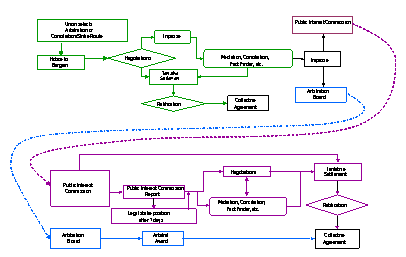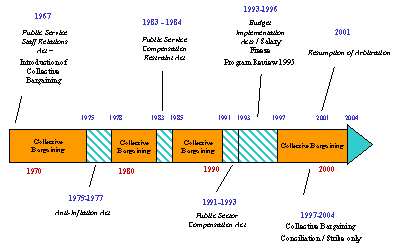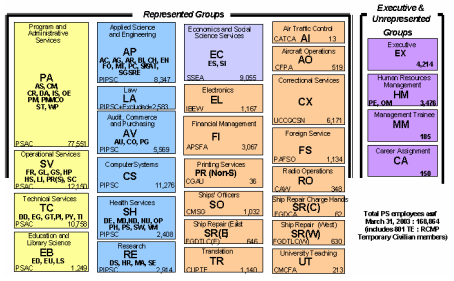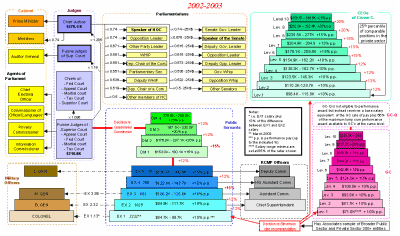Common menu bar links
Breadcrumb Trail
ARCHIVED - Expenditure Review of Federal Public Sector - Volume One - The Analytical Report and Recommendation
 This page has been archived.
This page has been archived.
Archived Content
Information identified as archived on the Web is for reference, research or recordkeeping purposes. It has not been altered or updated after the date of archiving. Web pages that are archived on the Web are not subject to the Government of Canada Web Standards. As per the Communications Policy of the Government of Canada, you can request alternate formats on the "Contact Us" page.
3. The Legal and Institutional Framework for Salary Determination
The legislative framework for collective bargaining in the federal public service is set out in the Public Service Labour Relations Act (PSLRA). Its predecessor statute was first enacted in 1967. [32] The Act recognizes the right of most federal public servants to organize in bargaining units, and to choose bargaining agents to negotiate terms and conditions of employment on their behalf with the Employer, which is either the Treasury Board or a separate employer recognized by statute.[33]
The PSLRA sets out two methods for resolving differences, or interest disputes, about the terms of a collective agreement. The first is the conciliation/strike route, which permits employees to strike if various procedural conditions are met. The second is the arbitration route, whereby an arbitration panel resolves disagreements.
Across the combined core public service and separate employer domains, there were in 2003 approximately 210,000 employees (about 88%) who are represented by one of over 20 certified bargaining agents. The Public Service Alliance of Canada (PSAC) was by far the largest union, representing about 68% of unionized employees; the Professional Institute of the Public Service of Canada (PIPSC) represented about 20%. The other unions ranged in size from over 9,000, as in the Canadian Association of Professional Employees, to as few as about a dozen, i.e. Canadian Air Traffic Controllers Association.
The PSLRA is administered by the Public Service Labour Relations Board (PSLRB), a quasi-judicial statutory tribunal. Among the Board's roles are:
- certifying bargaining agents,
- assisting with collective bargaining through such services as mediation,
- adjudicating complaints of unfair bargaining, and
- adjudicating grievances not resolved by the parties.
Figure 1002 illustrates the process of collective bargaining.
Figure 1002
Schematic of collective bargaining processes under the Public Service Labour Relations Act

Negotiations begin with an exchange of proposals by the parties, followed by face-to-face discussions aimed at agreeing on terms of a settlement. Either party may ask the PSLRB to provide third party assistance, which could take the form of a conciliation officer, a mediator or a fact-finder. If an impasse persists, a Public Interest Commission (PIC) or arbitration board may be established, depending on the dispute resolution route chosen by the bargaining agent at the outset. At any stage, the parties may revert to direct negotiations, with or without the assistance of a mediator, except when the parties have actually started to present their arguments to an arbitration board.
Public Interest Commissions are non-permanent bodies consisting of one or three persons, appointed by the Minister responsible, whose role is to assist the parties to resolve disputes and make recommendations for settlement. The Chairperson of the PSLRB recommends the appointment of a Public Interest Commission either at the request of the parties or on his or her own initiative. It should be noted that members of a PIC are selected from a list of persons jointly agreed to by the parties. The PIC will report its recommendations for settlement to the Chairperson of the PSLRB within 30 days of its appointment; the Chairperson will make the report public. If there is still no settlement by then, employees acquire the right to strike seven days after the PIC reports to the PSLRB, though the Act requires that a secret ballot strike vote be held before a strike may be called. The bargaining agent may authorize or declare a strike only within a period of 60 days following the vote, provided that it has received the majority support of voters.
The role of an arbitration board is also to hear the positions of the parties and to encourage agreement on a settlement. If the parties do not agree, the arbitration board considers the position of the parties and renders a binding arbitral award
Experience with collective bargaining
Collective bargaining in the federal public service has alternated with periods of statutory salary controls. Over the 37 years between the introduction of collective bargaining in 1967 and 2003, the process was suspended in whole or in part for at least 11 years in three distinct periods. As the timeline illustrates, the main interruptions of collective bargaining were these:
- 1975 to 1978–The Anti-Inflation Act
This legislation applied to the whole Canadian public sector (including provincial and local government organizations), and to private employers with at least 500 employees. Wage increases were capped at 10% in the first year, 8% in the second, and 6% in the third. - 1983 to 1985–The Public Service Compensation Restraint Act
This Act automatically extended all collective agreements for two years with annual salary increases of 6% in 1983 and 5% in 1984. This applied to the entire federal public sector. - 1991 to 1996–A series of measures essentially froze wage rates for five of six years.
- The Public Sector Compensation Act set wage increases at zero for 1991, and 3% for 1992.
- This was followed by the 1992 Budget Implementation Act (Bill C-113), which extended collective agreements for 1993 and 1994 with no wage increases.
- The 1994 Budget Implementation Act (Bill C-17) provided for a further two-year extension of the wage freeze, as well as a two-year moratorium on increments within pay bands, and a suspension of performance pay. In addition, the arbitration route was suspended, eventually until 2001. Crown corporations were not included.
Figure 1003
Periods of collective bargaining and salary controls from 1967 to 2003

Beyond these general interventions, the Government acted in the post-freeze period to force settlements with two specific groups. In 1999, Parliament passed a law imposing terms and conditions based on the employer's last offer[34] for the Correctional Services (CX) group in order to avert an impending strike in federal correctional institutions. In the same legislation, the Government gave itself the authority to impose a settlement to end a lengthy period of partial rotating strikes involving the Operational Services (SV) bargaining group, which includes eight classification groups in the skilled trades and general labour area. A settlement based on the last Treasury Board offer obviated the need to proceed with this authority.
Since 1997, when collective bargaining resumed, the process has worked more or less smoothly. The general pattern of economic increases for the first two years was 2.5% and 2%. For 1999, there was a one-year settlement at 2%, with a lump sum equal to between $625 and $1,450 per employee, depending on the group.[35] This arrangement was intended to prepare the ground for implementing the Universal Classification System, which in fact was eventually dropped by the Treasury Board in 2002. For the period from 2000 to 2003, the principal pattern settlement with the Public Service Alliance of Canada provided annual economic increases of 3.2%, 2.8% and 2.5%.
Salary determination for separate employers
All separate employers, with the exception of Canada Revenue Agency, must obtain their negotiation mandate from Treasury Board, and Governor-in-Council endorsement of their final collective agreements.[36]
According to the legislation establishing the Canada Customs and Revenue Agency, its own Board had authority to set bargaining mandates and approve collective agreements. Sub-section 58(2) of its legislation required: "Before entering into collective bargaining, the Agency must consult with the Treasury Board on its human resource plan, including the total increase in employee salaries or benefits." The Treasury Board also had a broad oversight capacity through the general budget approval process.
Parks Canada must obtain Treasury Board agreement to its negotiating mandate. But provided any resulting collective agreement is consistent with the mandate, Parks Canada does not need to obtain the Governor-in-Council's endorsement. As a matter of practice, the same approach is applied to the Communications Security Establishment.
Determining the elements of total compensation
For most employees in the core public service, most elements of total compensation are determined through negotiations with unions. For others, Treasury Board sets compensation using the references described below.
Negotiated collective agreements
The bulk of compensation for most employees is negotiated by representatives of the Treasury Board with the appropriate public service union. The resulting collective agreements, which typically run for about two or three years, specify pay rates and leave, and entitlement to allowances and premiums such as overtime and severance pay.
Occupational "classification" groups
The framework for determining salaries is called the occupational group structure. This structure aims to group employees doing similar work, who share what is called a "community of interest" in the context of collective bargaining.[37] As of March 1999, the structure established for the core public service domain included 25 occupational groups, each represented by one of 16 unions. In addition, there were four groups that are unrepresented.
This structure consolidated the 72 classification groups created in 1967, when collective bargaining was introduced into the federal public service. While the occupational group structure is used for collective bargaining purposes, the older classification groups are still prominent in people's minds for two main reasons:
- nearly all active classification standards[38] relate to the old groups; and
- distinct pay bands still exist for most of the older groups.
Particularly for this latter reason, we use the old structure of classification groups in analyzing salary details. Such an approach greatly facilitates historical comparisons. Figure 1004 illustrates the existing occupational group structure. Appendix E gives the names and two-letter symbols of each of the current occupational groups, the classification groups that reflect the pre–1999 occupational groups and the respective bargaining agents.
Figure 1004
Occupational Group Structure for the core public service domain, March 2003

National Joint Council programs
Health, disability and dental programs are also negotiated by the Treasury Board, but generally with all or most of the unions on the same terms, under the auspices of the National Joint Council. The National Joint Council, in existence since 1944, is a parity union-management forum for discussion and negotiation of various directives of general application in the public service. Topics covered include the Foreign Service Directives, the Travel Directive and the Isolated Posts Directive. The Council also deals with grievances relating to the application of these directives or appeals regarding access to the health, disability or dental plans.
Three separate employers, the Canadian Food Inspection Agency, the National Research Council and the Office of the Auditor General, participate as well in the work of the National Joint Council.
Statutory benefits
Pensions and certain programs such as the Supplementary Death Benefit and Workers' Compensation are determined by statutes enacted by the federal or provincial governments.
Non-represented employees
The terms and conditions of employment for employees who are not represented by a union are determined directly by the Treasury Board. In the case of the Executive (EX) group, Deputy Ministers and other appointees of the Governor-in-Council, the Government generally accepts the recommendations of the Advisory Committee on Senior Level Retention and Compensation, whose work is described in more detail below.
For other groups not represented by a union such as most lawyers, personnel officers and senior members of other groups who are excluded because of their managerial responsibilities, the Treasury Board sets the pay rates and benefit entitlements. Generally these follow relevant standards among unionized employees, with the addition of eligibility for some form of performance pay and additional voluntary employee-paid life insurance.
Interdependence of salary determination for top federal officials
In practice in 2003, salary determination for the most senior federal officials was interconnected across the various domains.
Figure 1005 summarizes the connections as they were in 2003 among the pay rates for public service executives and Deputy Ministers, the senior officers in the Canadian Forces and the RCMP, the CEOs of Crown corporations, and other Governor-in-Council appointees, as well as judges, parliamentarians, ministers, and agents of Parliament. The figure appears busy, but this has been done to distil a lot of information into one picture.
Figure 1005
Summary of the interdependence of salaries for top Federal officials, as of 2002–03

In the lower centre, we find the salary ranges for the five Executive (EX) and the four Deputy Minister (DM) levels. The Treasury Board sets the pay for the EX 1 level, normally on the basis of a recommendation from the external Advisory Committee on Senior Level Retention and Compensation–known currently as the Stephenson committee. In 2003, along with chair Carol Stephenson, this Committee included several high level leaders from the private and not-for-profit sectors. In recommending salary levels and benefits for the executive and DM groups, the Committee relies on an annual report by Hay Associates that compares total compensation[39] for senior officials in the federal government with remuneration paid to positions of comparable responsibility in the Canadian private and broader government sectors. The policy is to maintain equivalence at the first Executive level (EX 1), excluding long-term compensation such as stock options.
Once the EX 1 rate is set, the other EX and the DM salary ranges follow arithmetically. By policy, there is a 12% difference in the maximum salaries of two adjacent levels, except between EX 3 and EX 4, and between DM 1 and DM 2. These two transitions of 15% each correspond to the important moves into the Assistant Deputy Minister ranks, and to the rank of a full deputy head in charge of a department or agency, respectively. The salary rates for the top-level leaders in the Canadian Forces and the RCMP have a fixed relationship to EX salaries as shown in Figure1005. The salary ranges for Governor-in-Council appointees are also anchored to the core public service by the equivalence of the GC-Q3 to the Hay private sector data.
Salary ranges for Crown corporation CEOs, in the upper right corner of Figure 1005, are set independently of the EX/DM rates, based on a Hay Associates survey limited to private sector remuneration. Again the Stephenson Committee formulates a recommendation, on which basis the Governor-in-Council sets the salary ranges.[40] The same basic approach is employed to maintain equivalence of total compensation at the first level of CEO to the 25th percentile of private sector jobs at the same level, and to establish pay rates for higher levels as fixed multiples of the levels below.
The pay of regular "puisne" judges of provincial superior courts, as well as the Federal and Tax courts is set on the recommendation of an independent Quadrennial Commission. Generally, these commissions have supported alignment with the mid-point of the DM 3 pay range. Higher judges are paid increments from this basic judicial rate.
From this followed the pay of parliamentarians in 2003. The Prime Minister was paid the same as the Chief Justice of the Supreme Court. Members of Parliament (MPs) earned half of that amount. Ministers and the Speaker earned 74% of what the Prime Minister earned. Other positions in the House of Commons hierarchy were paid various fixed proportions of the Chief Justice/Prime Minister salary, as set out in the figure. Senators, and those with special roles such as Speaker or Whip in the Senate, earned the corresponding House of Commons amount, minus $25,000.[41]
Finally the salaries of agents of Parliament are also tied into this scheme. The Auditor General earns the same as a puisne judge of the Supreme Court, and the other agents such as the Chief Electoral Officer earn the same amount as regular judges of the Federal Court.
The whole structure, setting aside the pay of Crown corporation CEOs, depended, in effect, on two decisions: the EX 1 salary, as recommended by the Stephenson Committee, and the regular provincial superior/federal court judge's salary, set based on the work of the Quadrennial Commission, which itself tends to tie into the DM 3 salary.
The whole structure, setting aside the pay of Crown corporation CEOs, depended, in effect, on two decisions: the EX 1 salary, as recommended by the Stephenson Committee, and the regular provincial superior/federal court judge's salary, set based on the work of the Quadrennial Commission, which itself tends to tie into the DM 3 salary.
